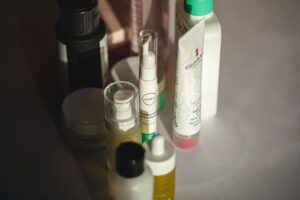A Shopper’s Guide

As the beauty industry undergoes a transformative shift towards sustainability and transparency, navigating the clean beauty aisle has become both empowering and daunting. With an array of products claiming to be “clean,” “green,” or “natural,” it’s crucial for consumers to understand the nuances of clean beauty and make informed choices. In this shopper’s guide, we will embark on a journey through the clean beauty aisle, decoding labels, uncovering greenwashing tactics, and discovering how to build a conscious beauty routine.
Understanding Clean Beauty
Clean beauty is more than just a trend; it’s a commitment to products that prioritize health, transparency, and environmental responsibility. At its core, clean beauty seeks to eliminate harmful ingredients such as parabens, sulfates, phthalates, and synthetic fragrances while promoting sustainability and cruelty-free practices.
Decoding Labels
The first step in navigating the clean beauty aisle is deciphering product labels. Familiarize yourself with key terms such as “organic,” “natural,” and “non-toxic.” Keep in mind that these terms can be subjective and may not guarantee a completely clean formulation. Look for certifications from reputable organizations like COSMOS, EWG Verified, or the Leaping Bunny logo for cruelty-free products.
Greenwashing Tactics
Greenwashing occurs when brands falsely market their products as eco-friendly or clean to appeal to environmentally conscious consumers. To avoid falling victim to greenwashing, critically examine product claims and look beyond buzzwords. If a product claims to be “all-natural” but doesn’t disclose its full ingredient list, proceed with caution.
Ingredients to Watch Out For
Educate yourself on commonly flagged ingredients in conventional beauty products. These include parabens, which are preservatives linked to hormonal disruption, and sulfates, known for their potential to cause skin irritation. Opt for products free from artificial fragrances, as they often contain phthalates, which have been associated with adverse health effects.
Building Your Conscious Beauty Routine
Now that you’re equipped with the knowledge to navigate the clean beauty aisle, let’s explore how to curate a conscious beauty routine that aligns with your values.
- Identify Your Priorities: Consider what matters most to you in a beauty product. Are you focused on cruelty-free options, sustainable packaging, or organic formulations? Understanding your priorities will help you narrow down your choices and make more intentional decisions.
- Research Brands: Dive into the ethos of beauty brands. Look for those committed to transparency, ethical sourcing, and environmentally friendly practices. Brands that prioritize these values often share their stories on their websites, providing insights into their manufacturing processes and ingredient sourcing.
- Read Reviews and Seek Recommendations: Leverage the power of online communities and reviews to discover clean beauty gems. Platforms like cruelty-free beauty blogs, forums, and social media groups can offer authentic insights into the efficacy and ethical practices of various brands.
- Explore Multi-Functional Products: Simplify your routine and reduce your environmental footprint by opting for multi-functional products. Look for items that serve multiple purposes, such as a tinted moisturizer with SPF or a lip and cheek stain.
- Consider Refillable and Sustainable Packaging: As sustainability gains momentum, many clean beauty brands are embracing eco-friendly packaging. Seek out products with refillable options, minimal packaging, or packaging made from recycled materials to reduce your environmental impact.
- DIY and Minimalism: Embrace the do-it-yourself approach by incorporating minimalistic beauty routines. Explore DIY face masks, toners, and scrubs using natural ingredients from your kitchen. Not only does this minimize your exposure to potentially harmful substances, but it also reduces waste.
- Support Local and Independent Brands: Discover hidden gems among local and independent clean beauty brands. These smaller businesses often prioritize ethical practices and provide a personalized touch to their products.
- Educate Yourself on Cruelty-Free Beauty: Choose products from brands that are committed to cruelty-free practices. Leaping Bunny certification is a reliable indicator of a brand’s dedication to not testing on animals. Many cruelty-free brands also display the certification on their packaging.
- Transition Gradually: If transitioning to a clean beauty routine feels overwhelming, take it one step at a time. Gradually replace your conventional products with cleaner alternatives as you run out of each item.
- Stay Informed and Adapt: The beauty industry is dynamic, with new information emerging regularly. Stay informed about clean beauty trends, innovative ingredients, and evolving best practices. Being adaptable allows you to refine your routine as new and improved products become available.

Empowering the Consumer
Navigating the clean beauty aisle is a journey of empowerment. By understanding labels, recognizing greenwashing tactics, and making intentional choices, consumers can champion their health, the environment, and ethical practices within the beauty industry. As you embark on this journey, remember that every conscious decision you make contributes to a cleaner, greener, and more transparent future for beauty. Happy exploring!




